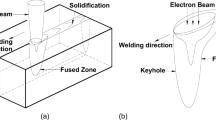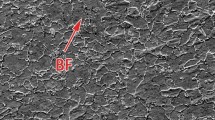Abstract
This paper concerns high-power laser welding of thick plates for the ship industry. Thermomechanical behavior during laser welding of 16-mm marine steel EH40 using 25-kW laser power was investigated by a 3D finite element model. The objective is to analyze the effects of weld collapse and hump on the residual stress-induced thermal cycle. A double-cylindrical source model was proposed to simulate the transient distribution of temperature field. Heat flow distribution area is a cylinder, radial heat flow presents a Gaussian distribution, while heat flow peak in the direction of thickness is decaying then increasing exponentially. The predicted weld geometry had good agreement with the actual results. When collapse and hump were considered, simulation error of temperature distribution was only 1.54%. In addition, cooling curves obtained from the thermal simulation were incorporated into the continuous cooling transformation diagram of EH40 to explain the evolution mechanism of microstructure. It was shown that collapse and hump affected the values and distribution trend of residual stress in different thickness, especially in the high gradient stress zone near the weld center. The collapse mainly affects the residual stress distribution on the top surface, while the hump affects that on the bottom surface. Both of them have little influence on the residual stress in the middle thickness area. The cold contraction of weld metal and the stress concentration caused by weld shape during the cooling process are the fundamental reasons that collapse and hump affect the distribution of welding residual stress.













Similar content being viewed by others
Availability of data and materials
All data generated or analyzed during the present study are included in this published article.
Abbreviations
- \(\rho(T)\) :
-
density
- \(c_p(T)\) :
-
specific heat capacity
- \(\lambda(T)\) :
-
thermal conductivity
- \(q(x,y,z)\) :
-
input thermal flux
- \(r_0\) :
-
radial distribution parameters of heat source
- \(h\) :
-
heat source height
- \(\lambda\) :
-
welding efficiency
- \(Q_1\) :
-
the upper power (part of the laser power)
- \(Q_2\) :
-
the lower power (part of the laser power)
- \(f_1\) :
-
radius adjustment coefficient
- \(f_2\) :
-
height adjustment coefficient
- \(h_1\) :
-
height of the upper part
- \(h_2\) :
-
height of the lower part
- \(T\) :
-
temperature
- \(h_c\) :
-
equivalent heat transfer coefficient
- \(d\varepsilon_{total}\) :
-
total strain increment
- \(d\varepsilon_e\) :
-
elastic strain increment
- \(d\varepsilon_p\) :
-
plastic strain increment
- \(d\varepsilon_T\) :
-
temperature strain increment
- \(A_{C1}\) :
-
initial temperature of austenite transition.
References
Unt A et al (2017) High power fiber laser welding of single sided T-joint on shipbuilding steel with different processing setups. Appl Sci (Switzerland) 7:(12)
Guo W et al (2016) Process-parameter interactions in ultra-narrow gap laser welding of high strength steels. Int J Adv Manuf Technol 84(9–12):2547–2566
Ibrahim OA, Lignos DG, Rogers CA (2016) Proposed modeling approach of welding procedures for heavy steel plates. Eng Struct 127:18–30
Balakrishnan J et al (2018) Residual stress distributions in arc, laser and electron-beam welds in 30 mm thick SA508 steel: a cross-process comparison. Int J Press Vessel Pip 162:59–70
Xu J et al (2019) Inhomogeneous thermal-mechanical analysis of 316L butt joint in laser welding. Opt Laser Technol 115:71–80
Ferro P, Berto F (2016) Quantification of the influence of residual stresses on fatigue strength of Al-alloy welded joints by means of the local strain energy density approach. Strength Mater 48(3):426–436
Farrokhi F, Endelt B, Kristiansen M (2019) A numerical model for full and partial penetration hybrid laser welding of thick-section steels. Opt Laser Technol 111:671–686
Rong Y et al (2018) Residual stress modelling in laser welding marine steel EH36 considering a thermodynamics-based solid phase transformation. Int J Mech Sci 146–147:180–190
Lee C (2007) Numerical analysis of residual stresses in welds of similar or dissimilar steel weldments under superimposed tensile loads. Comput Mater Sci 40:548–556
Ye Y et al (2015) Influence of groove type on welding-induced residual stress, deformation and width of sensitization region in a SUS304 steel butt welded joint. Adv Eng Softw 86:39–48
Elmesalamy AS et al (2016) Measurement and modelling of the residual stresses in autogenous and narrow gap laser welded AISI grade 316L stainless steel plates. Int J Press Vessels Pip 147:64–78
Serizawa H et al (2011) Effect of mechanical restraint on weldability of reduced activation ferritic/martensitic steel thick plates. J Nucl Mater 417(1–3):55–58
Yang X, Yan G, Xiu Y, Yang Z, Jiang W (2019) Welding temperature distribution and residual through experimental measurements and finite element analysis. Materials 12:(2436)
Brickstad B, Josefson BL (1998) A parametric study of residual stresses in multi-pass butt-welded stainless steel pipes. Int J Press Vessels Pip 75(1):11–25
Zhang L, Kannengiesser T (2014) Austenite grain growth and microstructure control in simulated heat affected zones of microalloyed HSLA steel. Mater Sci Eng, A 613:326–335
Banerjee K et al (2010) Nonisothermal austenite grain growth kinetics in a microalloyed x80 linepipe steel. Metall Mater Trans A 41(12):3161–3172
Deng D, Kiyoshima S (2011) FEM analysis of residual stress distribution near weld start/end location in thick plates. Comput Mater Sci 50(8):2459–2469
Funding
This research is funded by the National Natural Science Foundation of China (51905191), and Wuhan Scientific and technological Achievements transformation Project (2019030703011520). The general characterization facilities are provided by the Flexible Electronics Manufacturing Laboratory in Experiment Center for Advanced Manufacturing and Technology in the School of Mechanical Science &Engineering of HUST.
Author information
Authors and Affiliations
Corresponding author
Ethics declarations
Ethics approval
Not applicable.
Consent to participate
My co-authors and I would like to opt into In Review.
Consent for publication
Not applicable.
Competing interests
The authors declare no competing interests.
Additional information
Publisher's Note
Springer Nature remains neutral with regard to jurisdictional claims in published maps and institutional affiliations.
Rights and permissions
About this article
Cite this article
Wang, L., Zhang, G., Xu, J. et al. Effect of collapse and hump on thermomechanical behavior in high-power laser welding of 16-mm marine steel EH40. Int J Adv Manuf Technol 120, 2003–2013 (2022). https://doi.org/10.1007/s00170-022-08872-3
Received:
Accepted:
Published:
Issue Date:
DOI: https://doi.org/10.1007/s00170-022-08872-3




